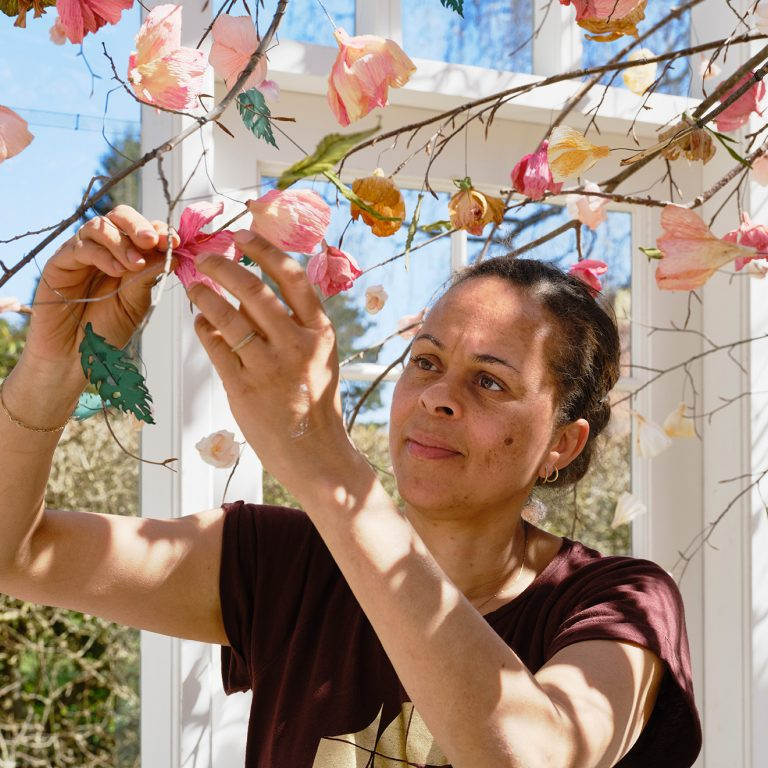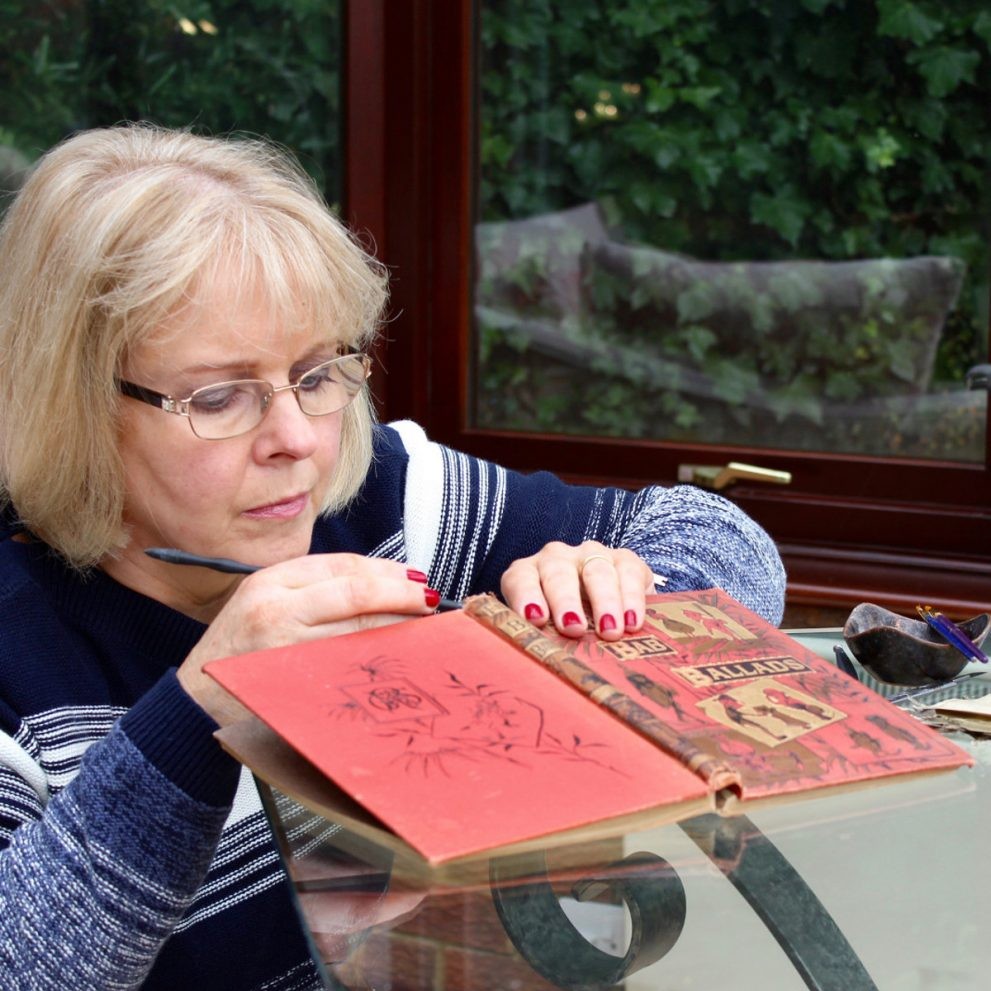Maria Francesca Batzella Paper Jewellery - Florence, Italy
Can you explain about the name LerènieS?
LerènieS is an anagram. I leave it up to curious minds to solve its meaning.

How long have you been making your paper jewellery for?
LerènieS started at the end of 2010, but the first jewel, called “Infinito”/ Infinity was “born” a year earlier – in 2009.
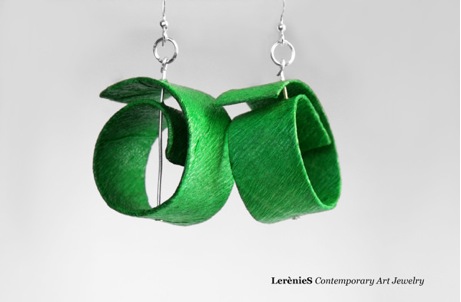
“Each creation is not really an end in itself, jewellery,but a sculpture” can you expand on this comment?
Each of LerènieS creation is unique and treated with individual care as a sculpture.
I manipulate the matter (in this case – the paper) in order to materialize an idea first as a sketch and then literally by hand, gradually developing the form and being flexible and sensitive to all changes. I have no modules, no pre-made patterns; for me this process is a pure art, and I treat it as such. The priority here is ART, which means that its functionality or dimensions are of more like of “an added value”, and what is more important is its originality and its artistic value.
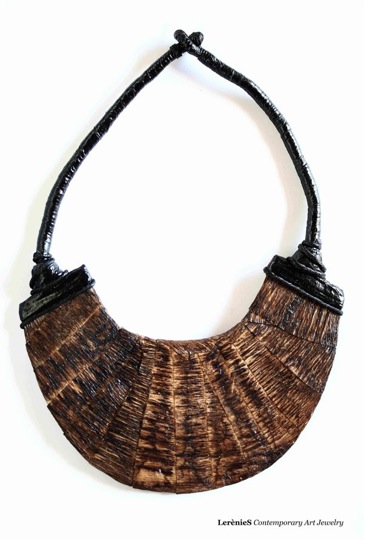
My necklace, a bracelet or an earring are not created simply to be used as ornaments, but these are fine-art sculptures that always have something to tell to a keen eye.
How did the idea come about?
The idea was born during the course of design at the Academy of Fine Arts in Florence. At the Academy I had participated in a competition for Contemporary Design, specializing in paper. I created my first piece of jewellery, called “Infinito” (Infinity), which has been much appreciated and was chosen for the final show. After having lots of success with this first piece, I decided to continue working in this direction and hence the LerenieS was born.

You graduated from the Academy of Fine Arts in Florence. Can you discuss how this training has helped you to develop your art?
I cannot say that my work has been at all influenced by the Academy. I am entirely self-taught and the project LerènieS comes directly from my mind and experience.
What jewellery training do you have?
I have three years of experience making my original jewellery all by myself.

You come from Sardina – how does the historical and archiolgical aspects of your home Region influence your work?
Sardinia is an ancient island: vast and underpopulated and in some ways it is still rather “wild”. The land itself is very attached to its beliefs, deriving from distant times, and still in a “silent” way follows its ancient traditions and rhythms. All of this has undoubtedly unconsciously influenced all of my works. Clean original modern design, evoking ancient “archetypical” symbolism offers another depth of aesthetic interest – immortal sacred shapes which once again become adorned and important.
You use recycled paper: can you expand on the different types of paper you use?
Usually I start my work with a piece of recycled carton, create several layers of scrap paper, until I reach the thickness I want. For example, an old box from salt, rolls of paper towels, or the pages of old books rendered useless for reading. The paper that I prefer is the crepe paper, but I don’t limit myself in experimenting with different other types of paper (at times also adding other organic materials) that come across my hand.
How do you give the paper a waterproof covering that is needed for the jewellery to be worn?
To make sure that the paper does not deteriorate when in contact with water (or body sweat), I treat only the outer surface of my creations with a solution based on acrylic polymers (similar to the product used for the reconstruction of nails).
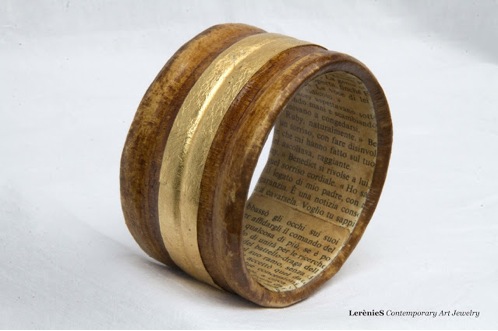
Can you take three pieces that have given you great pleasure on completion and discuss each piece?
Necklace, Guindalu “wrapped up”
Dimensions: Total length: approx. 94cm.

Inspiration: traditional Sardinian fine jewel-button of silver or gold in a shape of double-calotte (historically, Sardinian jewellery is strictly tied to the traditional costume). More than any other jewel, this one maintains the deep ethnographic meaning. This piece of jewellery, present both in masculine and feminine traditional costumes, possesses an aesthetic and archaic purity: reproducing a stylized feminine breast, it recalls ancient symbols of fertility and procreation, related to the neck in various ways, or simply worn at all of its length, as a necklace. Phoenician goddess, Tanit
Technical description, design and the choice of paper: the inferior part is composed from 13 elements (all from recycled paper) and 26 paper cords rolled from crepe-paper (black); Exterior part is composed of 52 chords of paper (crepe, black) all intertwined and 26 stripes of rolled crepe paper (red). It may either be wrapped around
Necklace, “Sollevami” Lift Me Up
Materials: Crepe paper, paper taken from pages of old books, gold imitation,
Egagrophiles (fibres of Posidonia sea-plant), vinyl glue diluted with water.
Dimensions: Total length: approx. 94cm.
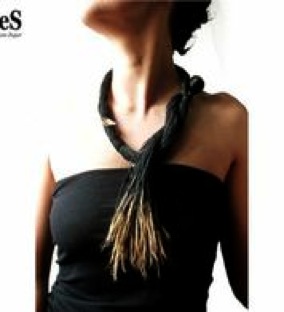
Technical description, design and the choice of paper: this necklace is composed of 213 chords of crepe paper rolled and joined in their length. Every single chord at its end has Egagrophiles wrapped around the chord and held up by a little bit of vinyl glue. There is also a unique chord, containing three little paper boats (covered with imitation gold), which unites all other chords and gives a visual flow to this necklace.
Inspiration: this piece was thought of and created specifically for the Biennale Habitat 2013 – Venezia (Biennial Habitat 2013 in Venice, Italy) and The Five Days of Mediterranean Community – (the theme was: The Sea…between dreams and reality).
Lift Me Up is an appeal in itself, it invites to be aware and to reflect the sad reality of the corporative contamination of the sea. Golden ships sail in the sea of black (recalling also petroleum, a.k.a. “the black gold”) leaving behind (ignoring) the spectrum of the sea – egagrophiles, the sea-plant, which reflects the purity of environment and does not grow in contaminated zones.
Bracelet, B 035: Mamuthones and Issohadores
Materials: recycled cardstock, crepe paper, coffee, gold leaf (imitation leaf), vinyl glue diluted with water.
Dimensions: Ø.: approx. 6 cm. W.: approx. 7 cm.

Inspiration: ISSOHADORES and MAMUTHONES (one of the most antic and striking masks of ancient Sardinian rituals, held annually in Mammoiada (Nuoro) in the central region of Sardinia).
The rite begins with two parallel rows of Mamuthones, who move at a slow pace of an ancient ritual, ringing the bells attached to their backs. The master Issohadore gives orders to Mamuthones and gives rhythm to the procession, while the other Issohadores, throw their lasso-rope (“soha”) trying to capture the persons from the audience (it is considered a sign of good luck and fertility if one gets caught by Issohadores). It is such an ancient tradition, that no one knows with certainty what the original meaning of this rite was – not even the people, who actually perform as Issohadores and Mamuthones.
Technical description, design and the choice of paper: the bracelet is divided diagonally in two halves– the first one (Mamuthones) is composed of many black chords of crepe paper, of approximately 1cm length with application of imitation gold leaf (applied irregularly and only found at the tips of chords – addressing the theme of bells, attached to domesticated animals – lined up in a way to imitate an appearance of an animal fur.
The second part is composed of 56 chords of crepe paper (white) placed horizontally (mask of Issohadores). The horizontal line, which divides the bracelet and represents the lasso of Issohadores (soha – in Sardinian language means “the rope”), and is composed of crepe paper – treated with coffee, in order to obtain the colour similar to that of “soha” (rope) – intertwined and stopped from both external parts with chords of red crepe paper (the colour of the jacket of Issohadores).
What is the philosophy behind LerènieS?
Today in the age of modern technologies and mass production, when there is a growing need to protect one identity and one’s culture, LerènieS wants to differentiate itself from the “world of mass-produced”, in order to create individual works of art (made entirely by hand) and of fine craftsmanship (mainly composed of unique pieces or limited editions), characterized by the philosophy of “beautiful and well-done” that has always distinguished the fine “made in Italy” brand.

Can you discuss the importance of shape: circular, spiral, and herringbone to your work?
If you look carefully at the findings of prenuragic (450000-1800 BC) and nuragic (1700 BC-second century BC) periods – and I am referring to the objects of daily use as well as items used for religious means – you will note that these forms are repeated, almost unchanged, and this kind of symbolic language occurs in different cultures in diverse parts of the world, as if it were a single and universally understandable language of signs. It is this aspect (a common and universally understood unconscious language of symbols), which gives a meaning to the choice of shapes and form in my work.


All your pieces are ‘limited editions’ due to the fact that they are handmade, you also have several pieces that are only made once. Can you discuss how this decision is made and when?
Essentially, all of my works are unique. There are few cases in which I have created limited edition pieces. I have to clarify that my limited editions come up to a maximum of 3 pieces, and each piece still differs from another for decorative reasons (i.e. in LE 007 series, one pendant differs from another by its decoration choice) or differs in size (LE 005 bracelets, LE 010) or keeps the shape, but differs in colour (LE 017 earrings, bracelets LE 012, LE 013, LE 014)
You also exhibit your work. How important are exhibitons to the development of your art?
I think it is of utmost importance to show your artistic work. Every art requires comparison, and without exhibitions art becomes an end in itself.

Where can your pieces be bought in Italy and perhaps internationally?
In Italy at:
Poncif Torino, Piazza Vittorio Veneto 5
Poncif Firenze, Borgo degli Albizi 35R
An joy, Via Eugenio Colorni 14, Roma
In Germany:
Aversente Arte Flowers / interior design, Frankfurt-am-Main
In USA:
Once In A Blue Moon Gallery, Edgartown, MA
Your work is done in yearly collections: how far ahead to you need to be?
The annual collection is intended as all work finished within a year. Whenever I conclude one piece, I immediately catalogue it and place it on my website.
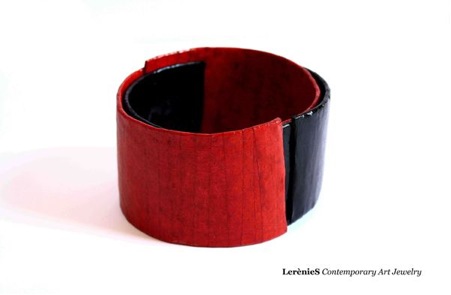
How does fashion influence your jewellery design?
I am not inspired by anyone in particular. My approach is artistic, I process and rework what I observe, trying to keep it as natural and “from within” as possible.

Contact details.
Website: http://www.lerenies.com
Maria Francesca Batzella, Florence, Italy
Interview by Deborah Blakeley, June, 2013
Think a colleague or friend could benefit from this interview?
Knowledge is one of the biggest assets in any business. So why not forward this on to your friends and colleagues so they too can start taking advantage of the insightful information the artist has given?
Other artists you may be interested in:




